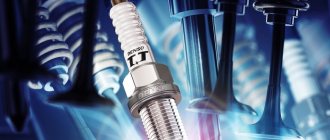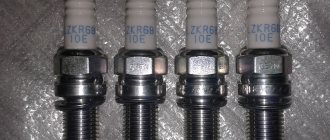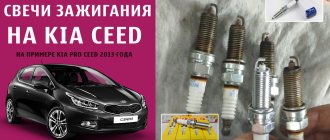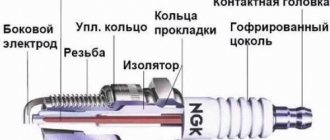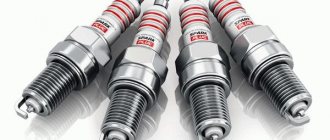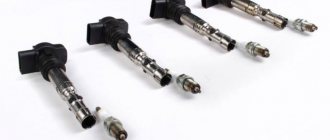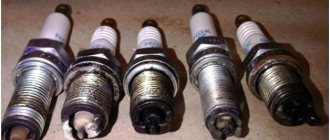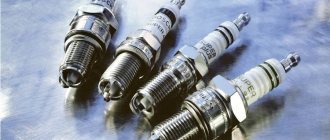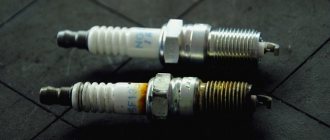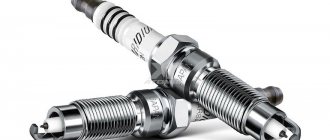The heat rating is perhaps the most important parameter of any candle. This parameter shows at what temperature spontaneous glow ignition will begin to occur. In the Soviet Union there was a table of the heat number of spark plugs, in which they were marked with numbers from 8 to 26. At the same time, the “hottest” ones had numbers from 8 to 14, and the “cold” ones more than 20. Abroad, there is no uniform marking and heat number table , each manufacturer uses its own labeling.
Next, we’ll figure out why this parameter is important.
What are spark plugs and why are they needed?
In modern internal combustion engines (ICE), the role of igniting the mixture of fuel and air (working mixture) is performed by spark plugs. In order to achieve the most complete combustion of the working mixture, the ignition timing must occur at a strictly specified time. If the mixture is ignited at the wrong time, then increased fuel consumption will occur, and the content of harmful substances in the exhaust will not meet the stated standards. In addition, the engine will not be able to develop its rated power.
It follows that violation of ignition operating parameters is unacceptable in modern engines, and even more so the appearance of glow ignition is unacceptable.
Modern candles provide all these parameters. They have very strict parameters. Since in modern engines they have to create a powerful, stable spark from 500 to 3500 times per minute.
Heat number
Glow ignition
Traditionally, spark ignition is used in gasoline and diesel internal combustion engines. Ignition of the fuel and air mixture is carried out due to an electrical discharge between the contacts of the spark plug. The spark jumps at the moment of full compression, ensuring residue-free combustion of the components.
Sometimes the spark plugs overheat and the hot electrodes ignite the mixture without a spark. It is not always possible to catch the right moment, which translates into interruptions in engine operation due to an insufficiently burned fuel assembly. Vibration and extraneous sounds appear. Fuel consumption increases, which increases the cost of the trip by a tidy sum.
This phenomenon is called “glow ignition,” that is, ignition from overheated electrodes. It must be avoided in every possible way, since in some cases (operation on vehicles with gas or hybrid engines) it can cause destruction of the spark plug and even an explosion of the engine. The heat number of spark plugs determines the operating mode in which the probability of sparkless ignition is maximally eliminated and the optimal temperature.
What is affected by the heat number of spark plugs?
To understand this issue, it is important to understand what heat ignition is, and what is the heat number of a spark plug? When any internal combustion engine operates, these parts heat up. When they are heated to operating temperature, the process of cleaning them from carbon deposits occurs. If it overheats, then after that the process of ignition of the working mixture begins not from a spark, but actually from its heated surface.
At the dawn of engine building, there were engines equipped exclusively with glow ignition, but now there are none and glow ignition is a very harmful process. With such ignition of the working mixture, it ignites at the wrong moment when it is required. This leads to a sharp decrease in power and increased load on the engine. Frequent occurrence of glow ignition can lead to very serious engine damage, including major repairs.
One of the reasons for the appearance of glow ignition may be the wrong choice of spark plugs or their failure. Next, using examples, we will understand what the heat number of spark plugs means.
From spark to heat one step
The spark mode of operation of the spark plug has a double effect on the operation of the spark plug itself. On the one hand, gradual heating promotes self-cleaning of the part from fuel impurities, which is of particular importance in domestic realities. But if the temperature of the spark plug continues to rise simultaneously with the degree of fuel compression, when it passes 900 degrees it turns into a glow plug. Control over the timing of ignition is lost, and the load on the engine increases sharply.
In motor vehicles, glowing spark plugs can cause serious consequences, including costly engine repairs. The only exception is operating transport models, where a glow plug serves as a heating element for a kerosene engine. Its operation is short-term - subsequently the engine operates due to the high temperature of the fuel mixture.
Many scientists were called to solve the problem of scuffing on the cylinder block due to incandescence. The result was a heat rating that corresponds to the maximum pressure level in the cylinder. It directly depends on the boost pressure.
What does the heat number of spark plugs mean?
As mentioned above, in the USSR the numbers indicating the heat number ranged from 8 to 26.
- The hot candles had numbers from 11 to 14;
- The middle candles had numbers from 17 to 19;
- Cold candles had numbers of 20 or more;
- Unified candles 11-20
The heat number of a spark plug characterizes a number that is proportional to the average pressure at which heat ignition occurs. This number was determined experimentally using a special calibration motor.
Completeness and marking of structures
Drivers should take note that at different times of the year, spark plugs are used in different conditions. Therefore, a set of “cold” candles is suitable for warm times, and vice versa. Thanks to this approach, you will not be afraid of winter traffic jams, and in the summer you will be able to drive safely at high speeds. The hot plug set is ideal for short distances and low speeds. “Cold” is the complete opposite.
The choice of spark plug type depends on the size of the motor. The longer the engine, the “colder” the spark plug will be. Even the same model can manifest itself differently in different engines. Its thermal capabilities will depend on the level of heating of the element during operation and how it will release this energy.
Candle manufacturers label their products depending on their inherent properties. For example, BP4ES is a design called “hot”, with a high degree of thermal energy absorption, which is caused by an elongated insulator skirt. The “cold” candle modification absorbs little heat. The reason for this is the characteristic short skirt of the insulator.
The main characteristics and dimensions of these elements are encoded in digital and letter designations.
Each design has its own meaning - surface shape, thread type, modification, heat index, thread length, material for electrodes, features of the electrodes - side and central.
Based on these values, the glow number of spark plugs is selected specifically for each brand of car. To buy spark plugs, visit the spare parts store from the TAM.BY catalog.
What is affected by the heat number of spark plugs?
“Hot” - used on low-power, low-boost engines. They remove carbon deposits very well, but if you install them on a highly accelerated engine, you risk that you will have a glow ignition and the engine will fail. For example, such engines were installed on Soviet passenger cars. And today they are installed on engines, for example, "Gazelle".
If you put “cold” spark plugs on a low-power engine. Then you run the risk that the parts themselves will fail very quickly. The fact is that warming up the engine will not be enough for them to clean them of carbon deposits. And very quickly it will coke and stop working.
So, from all of the above it follows that for the smooth operation of the engine you need to use spark plugs that are designed for use in this particular engine according to the heat rating. Otherwise, all sorts of troubles await you.
Characteristic
Denso spark plugs, judging by the reviews of many car enthusiasts, are today one of the highest quality and most effective products for the ignition system. Among hundreds of brands, Denso is the first to patent the TwinTip technology used in the TT production line. Such devices are made with a central electrode, which is made of nickel, with a reduced diameter, in this case it is 1.5 mm. It should also be noted that the size of the side electrode has similarly been reduced to 1.5 mm. The company produces products not only for gasoline engines, but also for gas (the author of the video is the DENSO Russia channel).
We invite you to familiarize yourself with the main features characteristic of Denso SZ, regardless of what heat rating they have:
- Products of this brand are characterized by improved discharge formation. If you believe the manufacturer, then in fact they achieve the greatest efficiency. It should be taken into account that the production of such products does not use precious metals, for example, iridium, and accordingly, the cost of such devices is lower. This is reflected in their final price.
- The iridium or platinum NW electrodes are made of iridium or platinum, respectively. The cost of such products is higher, but their service life is truly impressive. In the first case, it ranges from 60 to 120 thousand km, depending on the thickness of the central electrode, in the second - 70-80 thousand km.
- According to official data, Denso products provide improved performance at relatively low costs.
- To produce a spark and start a car engine, Denso SZ requires much less voltage. This means that the power unit can be started much faster, in particular, we are talking about starting in frosty conditions.
- Since Denso products have a thinner central electrode, the discharge itself will be more powerful, resulting in higher operating efficiency. This is also important in winter working conditions. As mentioned above, the electrode size is 1.5 mm, while in standard SZ it is about 2.5 mm.
Range
Now we invite you to familiarize yourself with the lines of devices produced by the Denso brand:
- Nickel TT;
- Iridium TT;
- Standard;
- Platinum Longlife;
- Iridium Power;
- Iridium Racing;
- Iridium Tough.
Photo gallery “SZ Denso models”
Advantages and disadvantages
For a more complete picture, we also recommend that you familiarize yourself with the advantages and disadvantages of SZ. We are talking about all models, and k20tt, k16tt, w20tt, ik20 in particular. You have compiled a list of pros and cons in accordance with customer reviews, so you can be sure of the veracity of the information below.
First, let's look at the advantages:
- When installing such sanitary protection systems, fewer harmful substances will be released into the environment. Due to the fact that the formation of a discharge on the electrodes of such SZ has become improved, the overall combustion process of the mixture in the engine will be more stable. Ultimately, the use of such protective equipment makes it possible to reduce fuel consumption and reduce the volume of harmful emissions into the environment. The advantage of reduced consumption is only relevant for those cars whose engines are tuned correctly and generally operate without failure . The savings themselves will be low - no more than 5%.
- Large selection of devices in different price categories. This allows you to select products for any type of car.
- Since spark formation has been improved, the combustion parameter of the combustible mixture also increases. This allows for ignition of even an excessively lean air-fuel mixture. Ultimately, misfires in the ignition system may continue to appear, but this will occur much less frequently.
- If your vehicle is equipped with a gas cylinder installation, then you can use products from the Tough line specially designed for such engines. Devices of this model are equipped with a platinum tip, which is installed on the side electrode. It should be noted that in fact such devices have higher wear resistance, and this is especially important for gas engines. This information is confirmed by consumer reviews. It is also necessary to take into account the fact that in general the temperature of the power unit when operating on liquefied gas is higher. So if the engine runs on such fuel, the combustible mixture will burn at a higher temperature.
- In addition, products from the manufacturer Denso have their own self-cleaning system. Thanks to the use of modern technologies in production, Denso produces products that, as a result of prolonged use, clean themselves. Such products are not afraid of the problem of soot, which ultimately also allows them to increase their service life.
- Iridium products are more resistant to corrosion, which can significantly increase their service life, as well as the quality of work (video author Mikhail Vlasov).
As for the minuses, they are as follows:
- The first drawback is that there are many fakes on the market. As you might guess, counterfeit products will not be able to boast such advantages as the original ones, at least because the heat rating in them is different. Accordingly, the service life of such devices will also be low.
- Separately, it is necessary to say regarding the service life. Judging by the reviews, in some cases it will be lower, in particular, owners of vehicles that run on gas and diesel write about this. In any case, even the reduced service life of gas SZ will still be higher than that of the same products from other manufacturers.
- High price. Everyone knows that high quality comes with high cost, but not all consumers can afford such devices.
- In addition, in some new spark plugs the gap itself is not adjusted to the working gap.
Marking
You can learn more about the markings, as well as the decoding of the symbols, from the table below.
How to find out the heat number of spark plugs
As mentioned above, in the USSR the heat value was marked on each candle. They do the same thing abroad. However, different manufacturers have different numbers and there is no uniform system. For example, the heat rating of NGK spark plugs starts with the number 2 (these are the “hottest” spark plugs) and ends with the number 12 (these are the “cold” parts). On the contrary, y start with the number 10 and go in descending order to the “cold” ones, which are marked with the number 2. For another well-known manufacturer of CHAMPION spark plugs, the “cold” ones start at the number 18.19, and the “hot” ones end at the number 53.
You can find out about heat rating markings from other manufacturers from the seller in the auto store, or on the websites of these manufacturers.
Heat number table
As a car owner, you should be aware that different spark plug manufacturers use different heat ratings. For example, a cold candle is a larger number, or a warm candle is larger. A modern Russian manufacturer sets the value to 14 and 17 , but the foreign Bosch will have an indicator of 8 and 7 . That is, we see an inverse relationship between these indicators. Thus, it is necessary to use a special table that shows the correspondence of heat numbers for different manufacturers. It is presented below in the image, and you can always use it when purchasing a particular candle.
Heat number table
In addition to the above, we recommend watching an interesting video on this topic:
What does the candle marking mean?
I already mentioned above that the heat number is printed on the candle itself. But where exactly to look for it in the labeling. Let's decipher the marking using the example of NGK BPR6E, which everyone can find on the hotline website.
Candle marking
So, the first letter in the marking is “B”. It means that the diameter is 14 mm. There may also be letters D and C.
- D corresponds to diameter 12 mm
- C corresponds to a diameter of 10 mm
Further in the marking there is “P”. This letter indicates that the device has a protruding insulator. The letter "R" indicates that it is a resistor.
But the number “6” is the same heat number. Considering that NGK’s heat rating ranges from 2 to 12, a spark plug with the number “6” represents the most common class of medium-sized parts.
Well, the last number “E” means that it has a long thread. If you see the letter “H”, then the thread of this part is short.
By the way, in the photo above, if you look closely, you can see the markings on the metal belt.
What determines the heat number of spark plugs?
Glow ignition occurs when the spark plug overheats. Therefore, the less it overheats, the “colder” the candle is. Typically, “cold” candles are more expensive than hot ones. Why this is so, I think it’s clear from the first sentence - on “cold” ones higher quality and, therefore, expensive materials are used. This leads to better cooling and prevention of glow ignition at extreme loads.
The coolest spark plugs are installed on racing cars, as well as on turbocharged cars.
Spark plug
Classification of candles
The minimum permissible heat number is 11, the upper limit is 26. The higher the heat number, the more heat is removed from the engine. Accordingly, there is less likelihood of uncontrolled glow ignition. This is reflected in the corresponding classification.
- Hot candles. CN range 11-17. Used for low-speed vehicles.
- Medium candles with boundaries 17-19. Needed in cars whose engines do not require much boost.
- Cold. Their heat number is 20-26. They are mainly used for sports and tuned car models.
The heat number is the main assistant in determining the type of spark plug required. If it did not exist, then car enthusiasts would spend huge budgets on the purchase of spark plugs alone. After all, an incorrectly selected part will either become covered with excessive carbon deposits or will not produce full power.
Checking the spark plugs
If some problems occur in the engine, the first thing to check is the spark plugs. Their appearance can provide fairly complete information about the condition of your engine.
So, you need to start checking the spark plugs by removing them from the engine. However, before removing them, you need to let the engine idle for some time. Of course, if they are still present on your engine.
But let's get back to the actual verification. After you remove the spark plugs from the engine, you need to check their markings and make sure that they meet the requirements for the make of your car.
If everything is in order with the markings, then simply visually inspect the electrodes. For a working spark plug, the color of the electrode should be whitish - bluish, and the carbon deposits on it should be minimal. If these requirements are not met, then there is a problem with your motor. By the appearance of the spark plug, with a 90% probability, you can find out what problems are with your engine. But this is a topic for a separate article and we will not touch upon it.
The glow number of the spark plug must exactly match the compression ratio of the engine. Conducted an experiment.
A spark plug is a part precisely tuned by engineers, which has its own optimal operating temperature at which it can operate for a long time without failure. And it doesn’t matter that it’s a spark plug from a top brand or the cheapest, their operating temperatures are the same.
Many people know that there are cold and hot candles. What does it mean?
A spark plug is considered cold for an engine when its thermal cone of the central electrode insulator does not heat up to a temperature at which the carbon burns out on it.
In order for the deposit to burn out, the heat cone must be heated to a temperature above 300 degrees.
If the spark plug is cold for a given engine, then it will become overgrown with carbon deposits and over time the spark on it will disappear, or its power will decrease.
Even if the engine is optimally tuned, carbon deposits still gradually form in the cylinders and therefore the operating temperature of the spark plugs is chosen in such a way that they can self-clean during engine operation.
I decided to conduct an experiment.
I decided to see how self-cleaning works in practice and how far you have to drive for the spark plug to clean. I took a candle whose insulator was covered with carbon deposits and even had a little oil on it.
He turned it into the engine. There was a lot of carbon on the spark plug, and so I thought that it would not produce a spark and the engine would misfire. But after starting, the engine ran fine and I decided to drive a short distance.
I drove about 3 kilometers. Then he stopped and unscrewed the spark plug.
Even in such a short distance, the candle managed to clean itself and the insulator turned white. This means that it managed to heat up above 300 degrees and the carbon burnt out.
It would have taken me much longer to clean this candle by hand.
